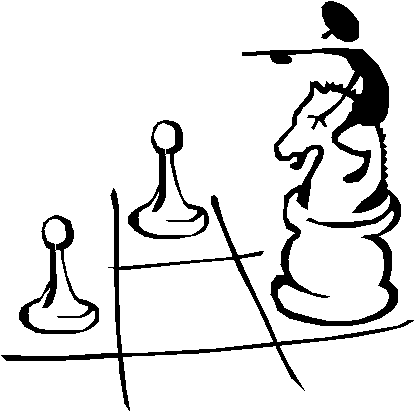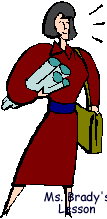Why Teachers Plan:

The
purpose of the lesson plan is to give you a guide to help your students learn
the material. If you are not clear on what you are going to teach and how you
will teach it, you will not be successful. Good teachers always know what they
are going to teach when they begin the lesson. A good lesson plan must contain
certain items that will lead you from the very beginning to the
assessment.
Teachers plan at various levels: yearly, term, unit, weekly, and
daily.
The Lesson Plan:
- Beginning Information
The development of a lesson plan starts
with some basic information about the plan that sets the boundaries or limits
of the plan. Here is a list of some information items:
-the grade level of
the students for whom the plan is intended
-the specific subject matter
(mathematics, reading, language arts, science, social studies, etc.
-the
name of the teacher
- The Focus of Your Lesson:
What are you going to teach? What is
your purpose?
The focus of your lesson may vary depending on the subject
matter being taught. The focus may be the solution to a problem, a skill you
are teaching or whatever topic you are dealing with that day. You must have
the focus of your lesson planned out and written down before you begin. Once
you have the focus, you can write your objectives
The instructional
objective(s) is the most important part of your plan because this is what you
intend to teach to your students, so, by the end of your lesson, your students
will be able to perform your objective. For example, if you are teaching the
3's times tables, your objectives might be the following:
- The students will be able to:
a. Say and write the 3's times table
quickly and correctly.
b. Count accurately by 3's to 18.
To check that you are writing your objectives correctly, remember that
you intend for your students to be able to perform or to be able to demonstrate
that they have learned. Make sure that you have an action verb in each
objective.
3. Materials:
The materials are what you will need to teach the
lesson. They can be simple or elaborate. You may just need the text with the
page numbers written down or you may need a TV and VCR etc.
If you are going
to have a fancy lesson or do an experiment, it is a good idea to make a list of
what you will use.
Always note page numbers.
4. Opening
Exercise:
This should be a 5-10 minute lesson that relates to what you
are about to teach. It should be presented at the very beginning of the class
either orally or on the board or overhead. You can use it to settle the class
and to give you some time to take attendance and gather your materials. You must
go over it and it must be something of importance. It can be:
-a review of
something that has been covered before
-a reminder of a skill that you will
be using in today's presentation
-a motivator to get the students ready to
think about today's topic.
Whatever you choose, remember that your students
will reach your objective more easily if they have their minds set in the
correct direction before you begin.
5. Motivator
The motivator is
used to get your students interested in the topic. It is a way of getting
everyone into the lesson. You can begin it in your opening exercise and develop
it at this point in the lesson. A good motivator can be short and, if possible,
personalized. Involve each student in what you are about to
present.
Examples:
1. Ask about broad concepts like fate or destiny.
2.
Ask students to apply the idea to their own experiences. Has anyone had good/bad
luck?
3. Bring in props like newspapers, posters, games, puzzles, photos,
whatever might apply to the lesson.
4. Play music, show a tape, read a story,
look at a cartoon
5. Write a quote on the board
6. Have students role play
or read a dialogue
6. Teaching and Questioning:Now is the time when you will present the
material for the day. The most important things to focus on are the questions
you will pose to your students. They should be of different ability levels and
follow the levels set forth in Bloom's Taxonomy. Most teachers' manuals give
questions like these in the margins of the pages. During this part of your
lesson you will want to model (to show in graphic form or to demonstrate) the
result that you want and to guide the students through the steps necessary to
perform the skill.
7. Checking for Understanding:
About halfway through the lesson
you need to check to see that your students are following what you have been
doing. You can usually do this by asking an easy question or by walking around
and looking over shoulders to see how they are doing.
8. Summary:
This should tie up what you have done during your
lesson. If you have written your objective on the board in the form of a
question, your students should be able to answer it or they should be able to
summarize the main points of the topic. You could also review what was
covered.
9. Assessment:
The summary can serve as your assessment or you
may want each student/group to write or verbalize something of importance that
you covered in your lesson. You may also use a quiz/test to assess your
work.
Major Categories in the Taxonomy of Educational
Objectives
(Bloom 1956)
Categories in the Cognitive Domain: (with Outcome-Illustrating Verbs)
Knowledge of terminology; specific facts; ways and means of
dealing with specifics (conventions, trends and sequences, classifications and
categories, criteria, methodology); universals and abstractions in a field
(principles and generalizations, theories and structures):
Knowledge is
(here) defined as the remembering (recalling) of appropriate, previously learned
information.
defines; describes; enumerates; identifies; labels; lists;
matches; names; reads; records; reproduces; selects; states; views.
Comprehension: Grasping (understanding) the meaning of informational
materials.
classifies; cites; converts; describes; discusses; estimates;
explains; generalizes; gives examples; makes sense out of; paraphrases; restates
(in own words); summarizes; traces; understands.
Application: The use of previously learned information in new and
concrete situations to solve problems that have single or best answers.
acts; administers; articulates; assesses; charts; collects; computes;
constructs; contributes; controls; determines; develops; discovers; establishes;
extends; implements; includes; informs; instructs; operationalizes;
participates; predicts; prepares; preserves; produces; projects; provides;
relates; reports; shows; solves; teaches; transfers; uses; utilizes.
Analysis: The breaking down of informational materials into their
component parts, examining (and trying to understand the organizational
structure of) such information to develop divergent conclusions by identifying
motives or causes, making inferences, and/or finding evidence to support
generalizations.
breaks down; correlates; diagrams; differentiates;
discriminates; distinguishes; focuses; illustrates; infers; limits; outlines;
points out; prioritizes; recognizes; separates; subdivides.
Synthesis: Creatively or divergently applying prior knowledge and
skills to produce a new or original whole.
adapts; anticipates; categorizes;
collaborates; combines; communicates; compares; compiles; composes; contrasts;
creates; designs; devises; expresses; facilitates; formulates; generates;
incorporates; individualizes; initiates; integrates; intervenes; models;
modifies; negotiates; plans; progresses; rearranges; reconstructs; reinforces;
reorganizes; revises; structures; substitutes; validates.
Evaluation: Judging the value of material based on personal
values/opinions, resulting in an end product, with a given purpose, without real
right or wrong answers.
appraises; compares & contrasts; concludes;
criticizes; critiques; decides; defends; interprets; judges; justifies;
reframes; supports.

Activity I
Create your own lesson plan. Use the information above, and the same
format that your teacher used in the example lesson plan. If you actually
implement this lesson, you can earn extra credit! All you have to do is
have your teacher write me a note saying that you actually taught the
lesson, and attach this note to your lesson plans. |
 

|